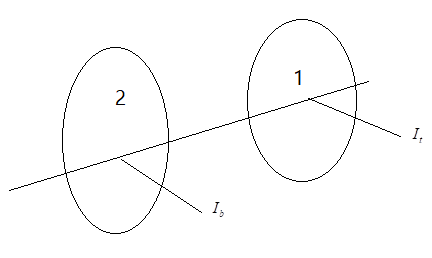
A circular disk of moment of inertia $I_{t}$ is rotating in a horizontal plane, about its symmetry axis, with a constant angular speed $\omega_{i}$. Another disk of moment of inertia $I_{b}$ is dropped co-axially onto the rotating disk. Initially the second disk has zero angular speed. Eventually both the disks rotate with a constant angular speed $\omega_{f}$. The energy lost by the initially rotating disc due to friction is
\[\begin{align}
& A.\dfrac{I_{b}^{2}}{2({{I}_{t}}+{{I}_{b}})}\omega _{i}^{2} \\
& B.\dfrac{I_{t}^{2}}{2({{I}_{t}}+{{I}_{b}})}\omega _{i}^{2} \\
& C.\dfrac{{{I}_{b}}-{{I}_{t}}}{({{I}_{t}}+{{I}_{b}})}\omega _{i}^{2} \\
& D.\dfrac{{{I}_{b}}{{I}_{t}}}{2({{I}_{t}}+{{I}_{b}})}\omega _{i}^{2} \\
\end{align}\]
Answer
514.8k+ views
Hint: Moment of inertia is the property of a given body to resist angular acceleration. It is defined as the sum of the product of the masses of every particle with the square of the distances from the chosen axis of rotation. It is also often known as the angular mass or rotational inertia.
Formula: $K.E=\dfrac{1}{2}I\omega^{2}$
Complete step by step solution:
To find the moment of inertia of the system we need to use the parallel axis theorem of the moment of inertia. Which states that, if $M$ mass of a body is rotated along the axis of the centre of mass of the body, then the new axis, which is parallel to the axis of rotation and at a distance say $d$, then the moment of inertia along the new axis $I_{new}$ is given as the sum of moment of inertia along the old axis and the product of the mass of the body with the distance between the two axis
Consider the two cases, initially only when disc 1 is rotating with a $\omega_{i}$ and has an inertia $I_{t}$ and the second is the system of two discs, where the system moves with $\omega_{f}$ and the inertia due to the individual discs is $I_{t}$ and $I_{b}$.

Clearly, there is no external force or torque acting on the system, then we can say that, then angular moment of the first and second cases, written as $L_{i}$ and $L_{f}$respectively are equal and conserved.
$\implies L_{i}=L_{f}$
$\implies I_{t}\omega_{i}=(I_{t}+I_{b})\omega_{f}$
$\implies \omega_{f}=\dfrac{I_{t}\omega_{i}}{I_{t}+I_{b}}$
Then, we know that the energies of the system is given as $K.E=\dfrac{1}{2}I\omega^{2}$
Then, here the loss in energy is given as $\Delta E=E_{1}-E_{2}$
$\implies \Delta E=\dfrac{1}{2}I_{t}\omega_{i}^{2}-\dfrac{1}{2}(I_{t}+I_{b})\omega_{f}^{2}$
$\implies \Delta E=\dfrac{1}{2}I_{t}\omega_{i}^{2}-\dfrac{1}{2}(I_{t}+I_{b}) \left(\dfrac{I_{t}\omega_{i }}{I_{t}+I_{b}}\right)^{2}$
$\implies \Delta E=\dfrac{1}{2}I_{t}\omega_{i}^{2}\left[1-\dfrac{I_{t}}{I_{t}+I_{b}}\right]$
$\therefore \Delta E=\dfrac{1}{2}I_{t}\omega_{i}^{2}\left[\dfrac{I_{b}}{I_{t}+I_{b}}\right]$
Hence the answer is option \[D.\dfrac{{{I}_{b}}{{I}_{t}}}{2({{I}_{t}}+{{I}_{b}})}\omega _{i}^{2}\]
Note:
The moment of inertia depends on the density of the material, the axis of rotation and the dimensions of the body, i.e. the shape and the size of the body. Its dimensional formula is given as $[M^{1}L^{2}T^{0}]$ with SI unit is $kgm^{2}$.
Formula: $K.E=\dfrac{1}{2}I\omega^{2}$
Complete step by step solution:
To find the moment of inertia of the system we need to use the parallel axis theorem of the moment of inertia. Which states that, if $M$ mass of a body is rotated along the axis of the centre of mass of the body, then the new axis, which is parallel to the axis of rotation and at a distance say $d$, then the moment of inertia along the new axis $I_{new}$ is given as the sum of moment of inertia along the old axis and the product of the mass of the body with the distance between the two axis
Consider the two cases, initially only when disc 1 is rotating with a $\omega_{i}$ and has an inertia $I_{t}$ and the second is the system of two discs, where the system moves with $\omega_{f}$ and the inertia due to the individual discs is $I_{t}$ and $I_{b}$.

Clearly, there is no external force or torque acting on the system, then we can say that, then angular moment of the first and second cases, written as $L_{i}$ and $L_{f}$respectively are equal and conserved.
$\implies L_{i}=L_{f}$
$\implies I_{t}\omega_{i}=(I_{t}+I_{b})\omega_{f}$
$\implies \omega_{f}=\dfrac{I_{t}\omega_{i}}{I_{t}+I_{b}}$
Then, we know that the energies of the system is given as $K.E=\dfrac{1}{2}I\omega^{2}$
Then, here the loss in energy is given as $\Delta E=E_{1}-E_{2}$
$\implies \Delta E=\dfrac{1}{2}I_{t}\omega_{i}^{2}-\dfrac{1}{2}(I_{t}+I_{b})\omega_{f}^{2}$
$\implies \Delta E=\dfrac{1}{2}I_{t}\omega_{i}^{2}-\dfrac{1}{2}(I_{t}+I_{b}) \left(\dfrac{I_{t}\omega_{i }}{I_{t}+I_{b}}\right)^{2}$
$\implies \Delta E=\dfrac{1}{2}I_{t}\omega_{i}^{2}\left[1-\dfrac{I_{t}}{I_{t}+I_{b}}\right]$
$\therefore \Delta E=\dfrac{1}{2}I_{t}\omega_{i}^{2}\left[\dfrac{I_{b}}{I_{t}+I_{b}}\right]$
Hence the answer is option \[D.\dfrac{{{I}_{b}}{{I}_{t}}}{2({{I}_{t}}+{{I}_{b}})}\omega _{i}^{2}\]
Note:
The moment of inertia depends on the density of the material, the axis of rotation and the dimensions of the body, i.e. the shape and the size of the body. Its dimensional formula is given as $[M^{1}L^{2}T^{0}]$ with SI unit is $kgm^{2}$.
Recently Updated Pages
Basicity of sulphurous acid and sulphuric acid are

Puzzle - Math and Logical Brain Teaser Puzzles for Students

Subtract 2-Digit Numbers Without Regrouping | Class 1 Worksheet

Class 2 Maths Pictograph Worksheet with Answers (Free PDF)

Class 1 Maths Months of Year Worksheet PDF – Free Printable Practice

Class 3 Maths Fractions and Decimals Worksheet PDF (Free)

Trending doubts
1 ton equals to A 100 kg B 1000 kg C 10 kg D 10000 class 11 physics CBSE

Knock knee syndrome is caused by A Fluoride pollution class 11 biology CBSE

Difference Between Prokaryotic Cells and Eukaryotic Cells

One Metric ton is equal to kg A 10000 B 1000 C 100 class 11 physics CBSE

1 Quintal is equal to a 110 kg b 10 kg c 100kg d 1000 class 11 physics CBSE

Proton was discovered by A Thomson B Rutherford C Chadwick class 11 chemistry CBSE




